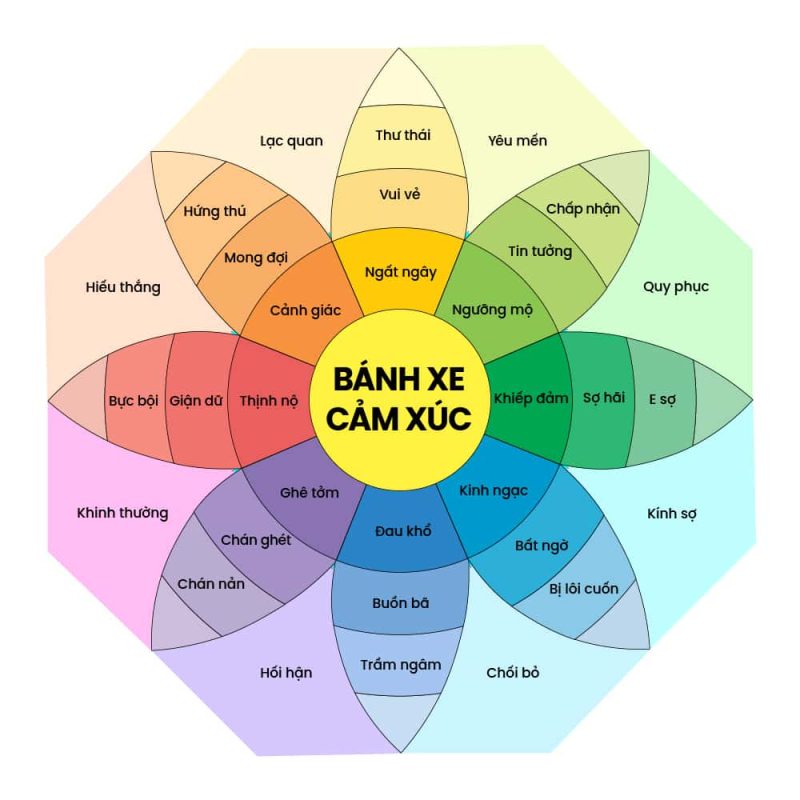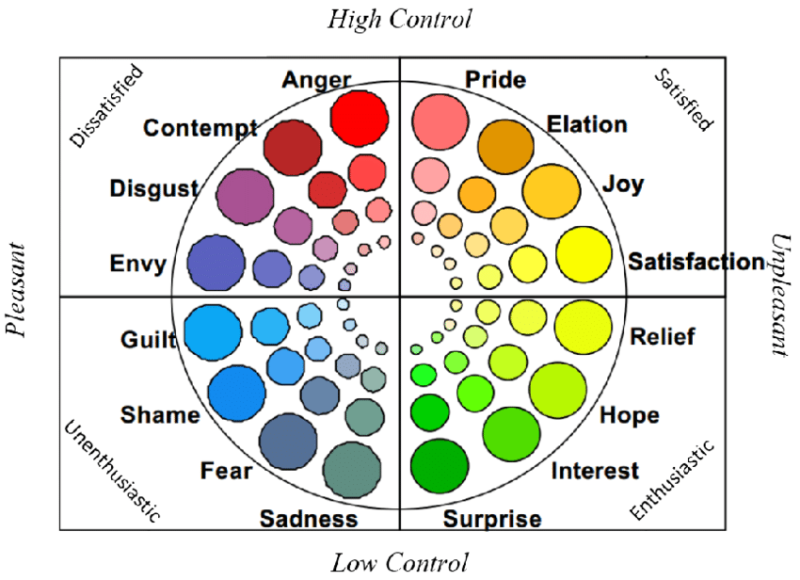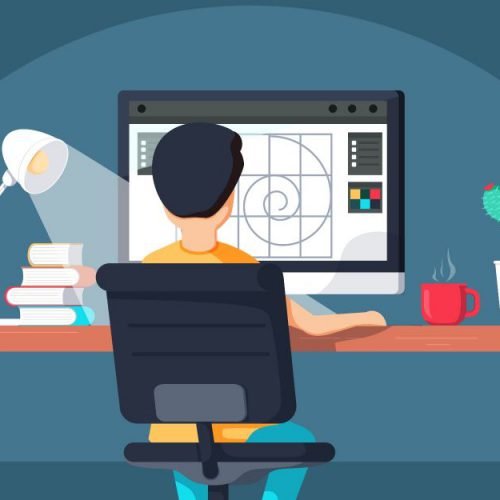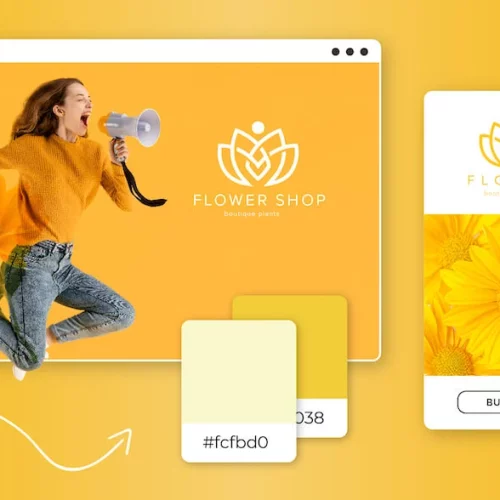![]()
Have you ever fallen into a state of “mixed happiness” , or “difficult to describe how I feel right now” ?
If the answer is yes, then congratulations, you have joined the “club of people who have trouble naming their emotions”.
This is nothing serious, as most of us have more or less experienced such moments. In fact, human emotions are much more diverse than emojis on Facebook.
To understand yourself and clearly define your feelings at a given time is a process. In this process, a powerful assistant that you cannot ignore is the emotional wheel .
Let’s learn about the “circle of emotions” to understand yourself and make yourself a better person!
What is the Emotion Wheel?
The legendary wheel of emotions we are talking about was proposed by professor Robert Plutchik in 1980. It is a classification system of emotions through which we can see that different emotions have can combine to form a different emotion. It’s like mixing colors. Each emotion has a different color.
According to him, there are 8 main types of emotions , arranged and illustrated in pairs of opposites as follows:
- Joy – sadness _
- Anger is the opposite of fear (anger-fear)
- Trust – disgust _
- Surprise – Anticipation _

10 Postulates for Plutchik’s theory of emotions:
This American professor’s theory of emotions was developed based on the following 10 postulates ( 1 ):
- The concept of emotions can be applied to all levels of evolution, including humans and animals. In other words, animals and humans have essentially the same emotional experiences.
- Emotions also have an evolutionary history and contain many different manifestations in different species.
- Emotions play an important adaptive role in helping us cope with survival problems.
- There are different emotional expressions in different species, but there are elements and patterns common to all.
- There exist a handful of basic, primary, and archetypal emotions that form each emotion.
- All emotions are obtained from association or in a state of arising. They are created from the combination, blending, and merging of the main emotions.
- All major emotions are hypothetical constructs or idealized states where attributes and characteristics are confirmed only through evidence.
- Major emotions can be defined in terms of pairs of opposites.
- The degree of similarity of emotions varies widely.
- Emotions exist in varying intensities.
To get a deeper understanding of what the emotional wheel really is, let’s take a look at the three important factors that make it up.
3 Elements of the wheel of emotions
1. Color
As mentioned, the eight main emotions include: joy, sadness, anger, fear, trust, disgust, surprise, and anticipation . These are basic human emotions.
Plutchik arranges them in the second circle in the emotional circle with each color distinct. For example, anger is red and joy is yellow.
2. The nuances
There are many different types of emotions that are developed based on the 8 basic emotions. You will see that the level of emotion is expressed by the intensity of the respective color. And the further you move to the center of the wheel, the more intense the intensity of the emotion.
For example, moving from the center of the circle, the level of emotion decreases from rage to anger , or from astonishment to surprise . Just like that, the more we move to the outside of the circle, we can see emotions with lighter shades, lighter colors.
3. Relationship between emotions
It is easy to find pairs of opposite emotions located in opposite positions of each other. It is interesting that two emotions standing side by side can combine and create a new emotion. For example, trust and joy combine to create love (joy + trust = love) . Similarly, trust and fear combine to create submission (trust + fear = submission) .
This formula creates a variety of emotions that you may have experienced before but can’t pinpoint what they are.
What is the effect of the emotional wheel?
The circle of emotions helps you understand your own feelings
Back to the case study question at the beginning of the article. Many times we fall into a state where we cannot name our emotions. At this point, it may be because you are not finding the right words to describe it. Simply being happy, sad, or angry is not enough.
So what happens when you don’t know what your feelings are?
The lack of awareness and avoidance of one’s own emotions has been shown to be very harmful to both physical and mental health. A 2013 study from the Harvard School of Public Health and the University of Rochester showed that people who regularly suppress their emotions have a 70% increased risk of being diagnosed with cancer . ( 2 )

Knowing how to use the wheel of emotions, you can identify and express your feelings in words more easily. This wheel’s “emotional vocabulary” helps you discover the richness of your emotions. From there, it’s easy to name any emotion in your experience.
Detect and control negative emotions through the emotional wheel
Facing and dealing with negative emotions is one of the essential skills in modern society. Especially in the context of the pandemic, when people are subject to a lot of regulations and restrictions. The disconnection between people has created countless pressures that have accumulated. Negative emotions can therefore appear, invade anyone’s mind and are ready to hurt them.
The key is to identify it and find a way to deal with it.
The first step is crucial: awareness . Through the circle of emotions, identify specifically the state you are going through, What can that negative emotion be among “depressed, disgusted, miserable, sad, ..”? Name specifically what you feel.
Next, once you’ve identified your negative emotion, “treat” it.

You can easily find that, if a negative emotion is not detected and processed, or if it is suppressed for too long, it can develop into a new negative emotion of greater intensity .
For example, if your sadness builds up for too long, it will grow into grief. Like a balloon being inflated with oxygen and just waiting to explode. At any time, a state of suffering can lead to negative actions.
Realizing this, you will easily find the cause/motivation that makes you negative, thereby controlling and softening it. For example, focus on some hobbies to free your mind from the bad thoughts that are beseting you.
The difference between Putchik’s emotional wheel and Geneva’s emotional wheel

Geneva’s circle of emotions also includes words that express human emotions to varying degrees like Plutchik’s wheel of emotions.
However, the difference between the two emotional wheels is that:
Putchik divides emotions based on 8 main emotions, from which emotions develop with different levels, creating pairs of opposites.
Meanwhile, Geneva lists 20 emotions, doesn’t specify which are the main emotions, and arranges them in four boxes, ranging from pleasant to unpleasant and from controllable to uncontrollable.
The second major difference between the two types of emotion wheels is how the intensity of the emotion is expressed. In Putchik’s emotional wheel, the closer to the center of the circle, the higher the emotional intensity. In contrast, in Geneva’s version, the inner circle indicates greater emotional intensity than the outer circle.
How to apply emotional circle in personal development?
More and more people are talking about “knowing yourself”. And understanding emotions is an important part of that “understanding yourself” journey.

We have talked about what is the emotional wheel, the benefits of this model, so how to use the emotional circle to really understand and develop yourself?
A simple way that you can apply is:
- Step 0 : Understand what the emotional wheel is. If you are still confused, do not hesitate to return to the content above to review.
- Step 1 : Identify the 8 basic emotions in the second circle and guess which one your current emotion is most similar to.
- Step 2 : With a primary emotion at the heart, identify specific emotions involved (which can be intense or mild) on the outer and inner edges of the circle
- Step 3 : Connect with your current feelings and locate your emotions among the emotions you just saw.
- Step 4 : Record the emotion you just discovered. Share it with anyone if you feel the need and comfort.
- Step 5 : Find the cause of that emotion (especially for negative emotions). Learn to be grateful if something makes you happy and don’t let negative emotions rule you.
Using the circle of emotions effectively, you can easily know how you would feel in a given situation. From there, it is easier to control emotions, regain the spirit after negative thoughts, avoid behavior and solve problems in a bad way.
Epilogue
Understanding emotions is not simply being able to name a state of mind in a given situation, but also knowing how to “deal” with it. Plutchik’s Wheel of Emotions will help you get there.




